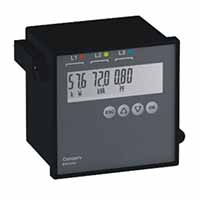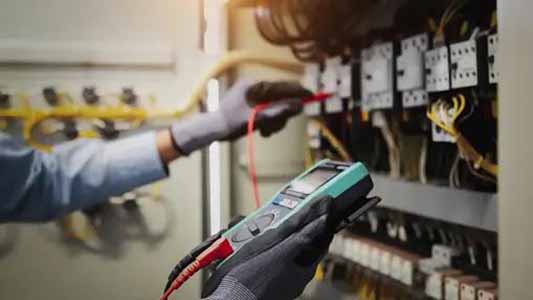Power and energy meters are devices that measure electrical parameters such as voltage, current, power, power factor, frequency, and energy in low-voltage installations. They are essential tools for test and measurement professionals who need to monitor, analyze, and optimize the performance and efficiency of electrical systems.
Power and energy meters can be classified into different types based on their functionality, design, communication protocol, current measurement, accuracy class, and approval. Some of the common types are:
- Multifunctional energy measuring devices: These devices can measure multiple
electrical parameters in all four quadrants of the power system. They have integrated communication interfaces such as Modbus/TCP, PROFINET, EtherNet/IP™, or MBUS for easy integration into networks. They can also connect directly to manufacturer-independent Rogowski coils for current measurement, which reduces wiring outlay and installation costs. Some examples of multifunctional energy measuring devices are EMpro energy measuring devices from Phoenix Contact1 and EM1000/EM1200 series from Schneider Electric.
- Power meters: These devices can measure active power and reactive power in single-phase or three-phase systems. They have digital or analog outputs for transmitting the measured values to other devices or systems. They can also have digital inputs for controlling external devices or functions. Some examples of power meters are PM1000 series from Schneider Electric and AcuRev 2000 series from Accuenergy.

- Energy meters: These devices can measure active energy and reactive energy in single-phase or three-phase systems. They integrate the power over time to calculate the energy consumption or generation. They have pulse outputs or communication interfaces for data logging or billing purposes. They can also have MID certification in accordance with EN 50470 for cost-center-specific energy data billing. Some examples of energy meters are EEM-EM325 from Phoenix Contact1 and AcuRev 1310 series from Accuenergy.
- Watt-hour meters: These devices can measure active energy in single-phase systems. They have a rotating disk or an LCD display that shows the accumulated energy consumption in kilowatt-hours (kWh). They are commonly used in residential or commercial applications for metering electricity usage. Some examples of watt-hour meters are DDS238-2 SW single phase DIN rail KWH meter from Eastron and DDS353B single phase electronic watt-hour meter from HPL India.
Benefits of Power and Energy Meters
Power and energy meters offer many benefits for test and measurement professionals who need to monitor, analyze, and optimize the performance and efficiency of electrical systems. Some of the benefits are:
- Energy management: Power and energy meters can help identify the sources and patterns of energy consumption or generation in a system. They can also help track the performance of energy-saving measures or renewable energy sources. By using power and energy meters, test and measurement professionals can optimize the energy usage and reduce the operational costs and environmental impact of their systems.
- Power quality analysis: Power and energy meters can help detect and diagnose power quality issues such as harmonics, voltage fluctuations, frequency deviations, unbalance, transients, or flicker in a system. They can also help evaluate the compliance of a system with power quality standards or regulations. By using power and energy meters, test and measurement professionals can improve the reliability and safety of their systems and prevent equipment damage or failure.
- Fault detection and troubleshooting: Power and energy meters can help locate and isolate faults or anomalies in a system. They can also help identify the root causes and effects of faults or anomalies on the system performance or efficiency. By using power and energy meters, test and measurement professionals can quickly resolve issues and restore normal operation of their systems.
- Data logging and reporting: Power and energy meters can store historical data or transmit real-time data to other devices or systems via communication interfaces. They can also generate reports or graphs that show the trends or statistics of the measured parameters over time. By using power and energy meters, test and measurement professionals can access valuable information for decision making or documentation purposes.
How to Choose a Power or Energy Meter
Choosing a power or energy meter depends on several factors such as the application, system configuration, measurement requirements, communication needs, installation space, budget, etc. Some of the key factors to consider are:
- Application: The application determines what type of power or energy meter is suitable for the system. For example, if the system is a single-phase residential load that needs only active energy measurement for billing purposes, a simple watt-hour meter may suffice. However, if the system is a three-phase industrial load that needs multiple electrical parameter measurement for power quality analysis purposes, a multifunctional energy measuring device may be required.
- System configuration: The system configuration determines how many phases, wires, voltages, currents, frequencies, etc., are present in the system. For example, if the system is a three-phase four-wire 400 V 50 Hz system with current transformers (CTs) for current measurement, a power or energy meter that supports this configuration must be selected.
- Measurement requirements: The measurement requirements determine what parameters need to be measured by the power or energy meter. For example, if only active power and active energy need to be measured by the meter, a power meter or an energy meter may suffice. However, if other parameters such as reactive power, reactive energy, power factor, frequency, etc., need to be measured by the meter as well, a multifunctional energy measuring device may be required.
- Communication needs: The communication needs determine what communication interfaces need to be supported by the power or energy meter. For example, if only pulse outputs need to be transmitted by the meter to a data logger or a billing system, a power or energy meter with pulse outputs may suffice. However, if other communication interfaces such as Modbus/TCP, PROFINET, EtherNet/IP™, or MBUS need to be supported by the meter as well, a multifunctional energy measuring device may be required.
- Installation space: The installation space determines how much room is available for installing the power or energy meter in the system. For example, if the system has a limited space in the distribution board or the control panel, a compact power or energy meter that can fit in a standard DIN rail may be preferred. However, if the system has more space available, a larger power or energy meter that has a display screen or a keypad may be preferred.
- Budget: The budget determines how much money is available for purchasing the power or energy meter. For example, if the budget is low, a simple watt-hour meter may be chosen. However, if the budget is high, a multifunctional energy measuring device with MID certification may be chosen.
If you are looking for high-quality power and energy meters, you can check out some of the products from these manufacturers:
- Phoenix Contact: Phoenix Contact offers a range of EMpro energy measuring devices that can be configured and integrated into your network in minutes. They have direct connection of manufacturer-independent Rogowski coils, MID certification, web server functions, and various communication protocols.
- Schneider Electric: Schneider Electric offers a range of EM1000/EM1200 series VAF/PF power and energy meters that are compact and easy to install. They have LCD displays, S0 outputs, digital inputs, MBUS interfaces, and MID certification.
- Accuenergy: Accuenergy offers a full line of power and energy meters that are precision engineered for high performance energy monitoring and straightforward system integration. They have multifunctional displays, data logging functions, relay outputs, analog inputs/outputs, pulse inputs/outputs, RS485 ports, Ethernet ports, WiFi modules, Modbus RTU/TCP protocols.
Conclusion
Power and energy meters are devices that measure electrical parameters such as voltage, current, power, power factor, frequency, and energy in low-voltage installations. They are essential tools for test and measurement professionals who need to monitor, analyze, and optimize the performance and efficiency of electrical systems.
Power and energy meters can be classified into different types based on their functionality, design, communication protocol, current measurement, accuracy class, and approval. Some of the common types are multifunctional energy measuring devices, power meters, energy meters, and watt-hour meters.
Power and energy meters offer many benefits for test and measurement professionals who need to monitor, analyze, and optimize the performance and efficiency of electrical systems. Some of the benefits are energy management, power quality analysis, fault detection and troubleshooting, and data logging and reporting. Choosing a power or energy meter depends on several factors such as the application, system configuration, measurement requirements, communication needs, installation space, and budget. Some of the key factors to consider are application, system configuration, measurement requirements, communication needs, installation space, and budget.












